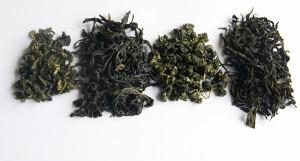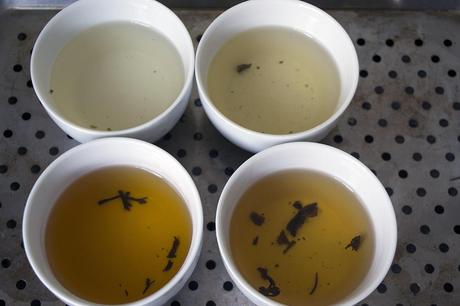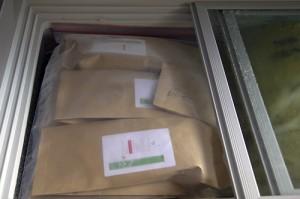Which tea is the healthiest? Despite this being one of the most frequently asked questions, there is no simple answer.
In the first article, we looked at some of the chemical compounds in tea and their associated health benefits.
In the second article, we looked how tea are classified and how processing affects the chemical content.
So theoretically, all you need to do is to seek out the chemical compound that helps you achieve your health related goal- such as lower cholesterol- and the category of tea that has the highest content then you are set. Right?
Again the simple answer is no. Let us look at the complex reasoning :)
More than one single determinant
If we recall the earlier article, Professor Yang Wei Li and his team produced tea from the same raw leaves and measured their chemical content.

i) White tea
ii) Green tea
iii) Oolong tea
iv)Dark tea
v) Yellow tea
vi)Black tea
Zhao He Tao studied the amino acid content across the 6 basic categories of tea based on a representative from each category and compiled the following table:
mg/100g
Category Black Green Tea Yellow Tea Oolong Tea White Tea Dark Tea
Variety Qimen Black Songlo Mengding Yellow Tea Wuyi Yancha Silver Needles Puer
L-theanine 1416.6 1944.7 1730.1 627.4 3007.9 71.1
Total amino acid content 2355.4 2780.0 2635.5 1117.1 4751.7 183.4
Table 1
If you ranked from most to least you would get:
i) White tea
ii) Green tea
iii) Yellow tea
iv) Black tea
v) Oolong tea
vi) Dark tea
In the second research, based on actual varieties, the amino acid content of oolong and dark tea is much lower as compared to the first.
This illustrates that method of processing is not the only determinant.
In this case, both oolong and dark tea are processed using matured leaves with 3-4 leaves per picking requirement as compared to 1 bud to 2 leaves in the first experiment.
Amino acid content though, is concentrated in the buds and younger leaves.
The second reason is cultivar. Puer is made from the Yunnan Dayezhong variety which are usually lower in amino acid content compared with xiaoyezhong.
Not all teas are created equal
How much of a difference can there be with chemical content within the same category of tea?
Massive.
Take a look at this extract from the USDA database of flavonoids.
Based on a category of tea they defined as “tea, green, brewed” measured on mg/100
Content Mean Sample size min max
EGCG 16.39 97 1.69 139.60
ECG 64.15 97 2.31 203.20
Within what is labeled as ‘green tea’, the highest content tested can be nearly 100 times more than the lowest.
Naturally if you drink something on the 99 percentile, the benefits reaped would be entirely different from that on the same scale.
Production
Rather than looking at more figures, here is an easy test.

These 4 teas are (clockwise from top left) Huangshan Maofeng, Wenshan Baozhong, Dongfang Meiren and Qimen Black.
The liquor color of a Wenshan Baozhong is closer to that of a Huangshan Maofeng than that of a Dongfang Meiren even though a Baozhong and a Dongfang Meiren are both Taiwanese oolongs.
In fact the Dongfang Meiren is closer in liquor color to that of a Qimen Black, a black tea.
Level of oxidation is just one way production of oolong tea can vary, though it is one of the most visibly identifiable.
Quality of Raw Leaves
There are so many variables here- soil, elevation, cultivar, shade, harvest period etc-I will just use one to illustrate- picking requirements.
This table[1] shows the chemical content of the leaves
Compound 1st Leaf 2nd Leaf 3rd Leaf 4th Leaf 5th Leaf Stem
Polyphenols (%) 16.97 20.08 18.22 16.05 12.88 10.39
Dissolvable substances (%) 46.61 45.16 44.60 43.05 40.45 38.04
Amino acid mg/100g 150.50 146.00 127.80 100.00 94.70 147.20
As seen, the more matured leaves have a significantly lower content of polyphenols and amino acids, although they are higher in other compounds such as tea polysaccharides for example.
As a general guideline- though it must be said this is very general- picking requirements of the different category of tea are as follows:
Green tea: 1 bud to 1 or 2 leaves
Yellow tea: bud for some, 1 bud 2 leaves for others
Dark tea: matured leaves, 4-5
White tea: bud only for silver needles, 1 bud to 2 leaves for white peony
Oolong tea: matured leaves, 3-4
Black tea: 1 bud to 2 leaves
Obviously there are exceptions- such as Liuan Guapian, a green tea which is made from matured leaves and Jin Jun Mei, a black tea that is made from buds only.
In fact, increasingly there is a trend of tea in China made from bud only.
Storage and Handling

Polyphenols especially are sensitive to heat, light, oxygen and moisture.
Improperly stored tea leaves would lose their polyphenol (and other chemical) content when exposed to these 3 elements.
Many common poor storage methods include:
- Storage in glass jars
- Non-airtight containers
- Transparent or flimsy materials
- Storage near heated areas
- No storing green tea below room temperature
- Exposure to sunlight
Particularly for commercial grade teas where packaging focus on aesthetics and not practicality, green tea in particular, due to its higher polyphenol content suffers from poor storage.
New Research
Right from the onset, we mentioned that there are more than 500 known substances in tea, some get more- such as ECGC and L-theanine- others are less covered.
For example, in recent years, reports have surfaced that thearubigins and theaflavins which are most prevalent in black tea are effective in certain benefits previously attributable to green tea polyphenols alone, for example stroke prevention.
Another example is white tea, because of its lower production, it gets lesser coverage but take the 2009 Kingston University research for example:
The researchers were blown away by exactly how well the white tea had performed. “We were testing very small amounts far less than you would find in a drink,” Professor Naughton, one of the country’s leading specialists on inflammation, said. “The early indicators are that white tea reduces the risk of inflammation which is characteristic of rheumatoid arthritis and some cancers as well as wrinkles.”
With China’s relatively recent affluence- in other words, research grant- and recent Western interest in tea, it is inevitable that we will see more new research coming up in tea that may disprove our earlier beliefs.
So What Then?
With all these considerations, how do you select which tea to drink if you are still looking for the healthiest tea?
That is a story for the next post.
See here for other frequently asked tea related questions
See here for more articles related to tea and health
[1] Table extracted from page 36 of 制茶学 edited by安徽农业学院 published by 中国农业出版社
